

European
Nuclear Society
e-news
Issue 21 July 2008
Not that long ago, during the dark days of the nuclear recession, public perceptions about nuclear energy were often largely conditioned by preconceived ideas and misconceptions. Unscientific rhetoric about nuclear had succeeded in banishing nuclear it to the fringes of the energy debate and maintaining its taboo status. Well, to quote Bob Dylan, “…the times they are a changing….” Nuclear energy is back at the top of the global political agenda. Even people who have always been unconditionally and ideologically opposed to nuclear energy cannot deny this fact. Today, they face a new foe that they have not faced in recent times – a confident and resurgent nuclear sector that is active at the very core of the debate.
As the nuclear revival has gathered momentum public opinion in favour of nuclear energy has increased, as nuclear’s strong security of supply and climate change credentials have become more apparent. This has promoted a new spirit of pragmatism. Many sceptics and fence-sitters have been won over. The results of the latest Eurobarometer survey, entitled Attitudes towards Radioactive Waste, which was published by the European Commission at the beginning of July, testify to this. They show that since the previous Eurobarometer on radioactive waste was published in 2005, there has been a gradual and significant evolution of public opinion in favour of nuclear power. There are now virtually as many EU citizens in favour of nuclear energy (44%) as against it (45%). This compares with 37 % in favour and 55% against in 2005. This suggests that there is no reason to believe that public opposition will prevent nuclear new build from going ahead.
Of course, radioactive waste remains a major concern but, according to the survey, 40% of those who are currently against nuclear have indicated that if the issue of radioactive waste storage were solved they would change their mind and be in favour of nuclear. A majority of EU citizens would then be in favour of it – 61% compared with the 57% registered in the 2005 Eurobarometer.
This positive evolution in public acceptance reflects the nuclear revival in Europe. Even in countries where a nuclear phase-out policy is being implemented, debates on the issue are taking place and support for nuclear power is quite strong (Sweden 62%, Germany 46%, Belgium 50%). Recent political declarations show that nuclear is continuing to gather momentum. In Italy the new government recently declared that it plans to restart the country's nuclear power programme. The British government revealed last month that it is planning the construction of new units. The French government announced on 3 July that a second EPR would be built in France. This suggests that when political decisions to increase nuclear capacity are taken, public acceptance tends to improve - as has been the case in the UK (+6%), and in Italy (+13%).
Another interesting statistic to emerge from the Eurobarometer is that the greater the knowledge of nuclear issues, the greater the degree of public acceptance. On average EU citizens do not feel that they are well-informed about nuclear maters, especially when it comes to radioactive waste. However, in countries where the level of knowledge is greater, like Sweden, Finland and the Netherlands, public opinion is also more favourable to nuclear power. It’s all about effective communications.
Before we all head off for a well-earned summer break it might be useful to consider how we could do more to positively influence public opinion through good communications, while at the same time giving deserved added visibility to the research that we carry out. The results of the Eurobarometer underline how everyone in the nuclear science community, whether working in industry or in research, has a joint responsibility to ensure that the right information about nuclear reaches the public. Informing the public that, for example, technological solutions for the safe long-term management of radioactive waste exist and are being applied must be a priority. If people knew more about Generation IV reactors they would soon realise that this new technology will actually help to reduce the amount of waste produced in the first place.
Perhaps we could have done more in the past. Perhaps communications have not been our primary focus. But with the revival in full swing and people more prepared to listen to us than ever before in recent times we have a great opportunity to set the record straight and inform people of the real facts – an opportunity that we cannot afford to miss.
ENS PIME 2009 will take place in Edinburgh from February 15 – 17. It offers all those in the nuclear community who are actively involved in communications the opportunity to share their experiences with their peers, to discuss the latest communications issues and techniques, to learn new communications skills and to master new tools. I strongly recommend that you participate in PIME 2009 to fine tune your communications skills. As the Eurobarometer has shown us, the more people know about nuclear the more they are in favour of it. As far as communicating to young people is concerned – and I’m sure our friends from the Young Generation would agree - the facts clearly and simply communicated can also help attract more talented individuals to a career in nuclear science or industry – something that would be in everyone’s interest. So, let’s get out there and do all we can to make it known to the public. We’re walking the walk, now let’s talk the talk.
ENS NEWS N° 21 kicks off with the traditional Word from the President feature. This time the President focuses on the important role and work of ENS’ High Scientific Council, before highlighting its Position Paper on research Reactors that was published at RRFM 2008, in Hamburg. Andrew Teller’s analytical eye then focuses on the subject of how climate change is not the sole issue that supports the case for nuclear energy.
The ENS Events section first reflects on a very successful NESTet 2008 conference, which put the debating spotlight on the subject of education and training in the nuclear sector. It then looks forward to what promises to be an extremely busy conference schedule in 2008 and 2009, with detailed information on upcoming events like Top Safe 2008 (Dubrovnik, 30/09 – 3/10), PIME 2009 (Edinburgh, 15 - 17/02) and RRFM 2009 (Vienna, 22 – 25/03).
This edition’s Member Societies and Corporate Members section has a record number of contributions that look at a range of subjects from the latest information on high pressure boiling reactors, to NUSIM - the joint conference of the Czech, Slovak and German nuclear societies; from the MINA 2008 conference (Spain) on new nuclear engineering applications, to spent fuel pool emptying and drainage at the EUREX plant, in Italy.
The summer focus on the Young Generation’s recent activities first returns to NESTet 2008, with a youthful and informative insight into the vitally important subject of recruiting the nuclear engineers and scientists of tomorrow. Next up is a report on the latest conference organized by the North American chapter of YGN, in Chicago, which concentrated, among other things on the multinational and multicultural challenges that the nuclear renaissance poses.
At was is a very busy time for EU nuclear energy policy, the bumper European Institutions section provides readers with a detailed analysis of the progress of the European Nuclear Energy Forum (ENEF), the latest EU carbon avoidance figures and a FORATOM position paper on nuclear energy’s contribution to post-Kyoto climate change policy.
ENS NEWS N° 21 is rounded off with a couple of NucNet headline stories from the beginning of July.
On behalf of everyone at ENS I would like to wish all ENS NEWS readers a great summer holiday.
http://www.euronuclear.org/e-news/e-news-21/presidents-contribution.htm


The High Scientific Council (HSC) plays an important role within ENS. Its remit is to bring to the attention of the scientific community, as well as the wider public, information on the very latest developments in cutting edge scientific research and development. As an expert body of senior and highly-qualified scientists it provides a very authoritative and informed view of the latest scientific developments taking place in the nuclear science community. I have had the pleasure of knowing and working with a number of HSC members for some time and always attached a great deal of importance to what they have to say about the major issues that are driving the international nuclear research agenda.
Part of the High Scientific Council’s mission is to report on what was discussed and presented at each of ENS’ major conferences. RRFM is a well-established and much-respected flagship ENS conference. With the nuclear revival gathering momentum across the world the work that is being carried out into research reactor design and constantly improving fuel management is all the more relevant and significant. The following HSC position paper was written by Bernard Bonin of the CEA, in France, following RRFM 2008 (in Hamburg).
Before you read this interesting position paper I would like to take this opportunity to wish you and yours a restful and – hopefully - sunny summer break.
David Bonser
ENS President
RRFM is the occasion, once a year, to review the status, operation and evolution of research reactors around the world, including material testing reactors (MTRs) and irradiation facilities, neutron sources for condensed matter studies, reactors for radioisotope production, reactors for education and training, and critical mock-ups for reactor physics. The total number of research reactors in the world is decreasing, as many reactors are ageing and are not being replaced. It is hoped that this situation will stabilise soon: a further decrease of the fleet could be detrimental to the community. With regards to the reduction of research reactors, the principle of “coalitions” is proposed and promoted by IAEA, to give access to reactor to several neighbouring countries. Such coalitions could be most effective in Latin America and in Africa.
In Europe, there are basically three major research reactors projects: the Jules Horowitz reactor in Cadarache (France), which is intended to replace the ageing Materials Testing Reactor “OSIRIS” in 2014; the PALLAS facility, which will replace the High Flux reactor in Petten (the Netherlands) and the MYRRHA project, which is dedicated to the study of accelerator-driven sub-critical cores. Good news from the Jules Horowitz Reactor (JHR) project has been reported, as the financial aspects of the project have been settled with participation confirmed from many countries, including India. Whereas the construction of the JHR has already begun, the status of the PALLAS and MYRRHA projects is more uncertain.
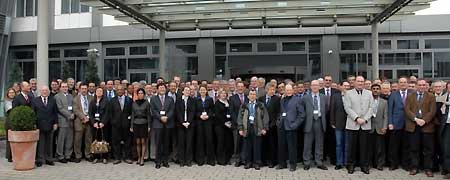
The biggest issue at the conference was the progress made in the conversion of the cores of research reactors from highly-enriched uranium (HEU) to low-enriched uranium (LEU). The programme of core conversion was initiated back in 1978 under the auspices of the US Department of Energy. It supports the minimization and, to a certain extent, the elimination of the use of HEU in civilian nuclear applications.
As of 2008, a total of 207 research reactors were involved in the project worldwide. 56 have already been converted, 78 are beyond scope, and 46 are planned for conversion with existing LEU fuel. The remaining 28 are high performance reactors, also planned for conversion but these will need fuel of a new type to comply with core conversion without losing too much in performance. The challenge for this new fuel development was extensively analysed during the conference.
The permanent challenge of research reactors devoted
to testing or irradiation is to produce high neutron fluxes with limited
amounts of fissile material. This in itself is a constraint as it already
points to the need for fuels with a high density of fissile matter. Conversion
of research reactor cores to LEU has made the need for dense fuel all the
more urgent. The intermetallic compound U3Si2 is
presently the reference fuel, with a well mastered production process on
the industrial scale and a good behaviour profile under irradiation. But
its density is only 4.8 gU.cm-3, and this is clearly not sufficient
for the conversion of some of the more demanding research reactors. Higher
densities can be reached by switching to UMo alloy, where the 7-10% Mo
additive has been chosen for its capacity to stabilize the gamma phase
of uranium. Monolithic UMo alloy has a density as high as 16 gU.cm-3;
UMo can also be made of powder, sandwiched between two co-laminated plates
of Al. The density of the powder (called “meat” in the specialist’s
jargon) at the centre of the sandwich is then limited to about 8 gU.cm-3.
The behaviour of this type of fuel plates has been tested under irradiation
in various laboratories, with as yet not entirely satisfactory results.
The general finding is that the Al matrix interacts with the UMo alloy
to form an interaction layer where the gamma phase of the uranium crystal
lattice is locally destroyed, with negative consequences on the behaviour
of the fuel under irradiation (the swelling and pillowing of the fuel plate
can modify the cooling of the fuel and cause its buckling; the fission
gas release can cause blistering of the plate and cause its ultimate rupture).
The addition of 2-5% of Si either in the Al matrix or in the UMo itself
seems to limit both the development of this indesirable, mainly amorphous
interaction region, and the resulting swelling. Reports from all laboratories
confirm the positive role of Si on the fuel behaviour under irradiation.
The phenomenology of the role of silicon is being better mastered, as silicated
phases located at the interface between UMo and Al play the role of a diffusion
barrier, which limits the development of the amorphous interaction layer.
Cumulated fission rates as high as 5.1021 fissions.cm-3 in
the fuel grains, corresponding to burn-ups of 10 %, have been achieved
with UMo fuels in powder form. Alternatives to the aluminium cladding have
been researched (stainless steel, zirconium alloy), with promising results
so far. Altogether, the UMo fuel is by no means produced, even less qualified
on the industrial scale. It is hoped that the promising additon of Si will
ultimately result in a well-mastered fabrication process, with satisfactory
fuel performance under irradiation. But progress is slow. Some of the more
advanced research reactors will have to wait for this new type of fuel
to achieve core conversion.
The US National Nuclear Security Administration recently issued a request for
information, or RFI, on the nuclear industry's capability to fabricate very-high-density
low-enriched UMo fuel for research and test reactors. According to RFI’s
very ambitious schedule, the qualification of monolithic fuel for use in US
reactors by the US Nuclear Regulatory Commission is anticipated for 2011.
The RRFM conference was not entirely devoted to core conversion. A significant part of what was communicated concerned core calculation. The 2008 edition of the conference has confirmed the generalisation of the use of Monte Carlo codes for the neutronic calculations. Coupled neutronic-thermal hydraulic (NTH) calculations are more and more frequently undertaken. The IAEA has proposed to launch a Coordinated Research Project (CRP) devoted to the benchmarking of these NTH calculations. The European Nuclear Society welcomes this initiative and will follow its developments.
The High Scientific Council of the European Nuclear Society
http://www.euronuclear.org/e-news/e-news-21/listening.htm


Nobody denies global warming nowadays, but some scientists do question its causation by man-made carbon dioxide (CO2) emissions. In a nutshell, their analysis goes like this1:
The two most important greenhouse gases are by far water vapour and CO2. The former is at least 27 times more abundant than the latter and has an infrared absorption power eight times as high, which explains why the responsibility for greenhouse effect rests overwhelmingly with water vapour. A detailed calculation shows that the share of responsibility is 99.4% for water vapour and 0.45% only for CO2.
The atmosphere content of CO2 is controlled by two “sinks”, vegetation (terrestrial and marine) and the oceans, which contain 50 – 60 times more CO2 than air. When the average temperature of the earth increases, the solubility of CO2 in seawater decreases and a slight degassing of the oceans takes place, thereby increasing the CO2 content of the atmosphere. The increase in the CO2 content of the atmosphere would, therefore, be a consequence of global warming and not its cause, as is widely held.
Anthropogenic emissions of carbon dioxide represent less than 1% of the carbon dioxide content of the atmosphere. Consequently, the contribution of anthropogenic emissions amounts to less than 1% of 0.45%, i.e. 45 parts per million which is completely negligible.
To a layman such as me, the above views do not seem to contain obvious shortcomings. They are, however, in sharp opposition with those of the International Panel on Climate Change (IPCC), the UN-appointed body investigating the matter. My purpose is not to use this column to spark an argument which, as has been seen in the past, can easily turn sour. Let me just point out that the resolution of this difference is in principle very simple: either the sceptics’ analysis is beside the point or it isn’t. In the first case, this is worth demonstrating by those upholding the official position; the IPCC theory can only gain from being seen as capable of overcoming objections based on scientific reasoning. In the second case, the said objections should be taken into account as a matter of urgency, given the magnitude of the measures envisaged to combat a climatic evolution over which we would actually have no control whatsoever.
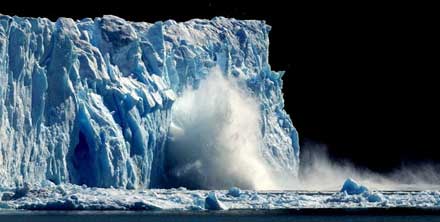
I would rather reflect on the consequences for nuclear energy of the possible conclusion that, after all, human activities play no meaningful part in global warming. Would such a conclusion deprive nuclear energy, as a CO2-free source, of its raison d’être? The answer is clearly no, because global warming is but one piece of the puzzle humankind must solve. It is worth recalling the other elements from time to time, lest we lose track of an important part of the big picture. So let’s review the other main reasons why nuclear must be a part of the solution, all climatic concerns set aside.
Diversification: this conceptcovers two equally important aspects of security of supply.
Fuel procurement: the different sources of energy we can consider are available in different quantities in different parts of the world. Uranium contributes to the diversification of many countries’ energy sources and therefore enhances security of supply.
Avoidance of production bottlenecks: recent events have made it painfully clear that production capacities cannot be rapidly adjusted to growing needs without causing disruption somewhere in the economy. This has been the case with the diversion of corn crops to the production of biofuels that triggered a sharp price increase at the beginning of 2008. The spectacular increase of the cost of petrol is likewise ascribable to some extent to a lack of refining capacity. Sharing the burden of building the needed generation capacity between different technologies can only reduce the threat of production bottlenecks.
Concentration: this feature is all too often overlooked. Nuclear fuel is a highly concentrated source of energy: a few lorries are enough to keep a nuclear reactor running for a whole year. A coal-fired unit of the same power would require many more lorries every day in order to fulfil its purpose. This might not seem very important to many, but not to those who are aware of motorways crowded by uninterrupted queues of lorries, e.g. in the Beijing area, or of saturated railway networks striving to keep coal-fired power stations in operation. The high concentration of nuclear fuel is admittedly the cause of the high toxicity of its waste, but this is no reason for ignoring its positive aspect: every cloud is entitled to its silver lining.
Additional resource: being relieved of the need to limit CO2 emissions does not relieve mankind from the duty to evolve to a more sustainable way of life. The predictable decrease in fossil reserves has finally started to sink in the collective awareness. Most renewable energy sources are ill-suited to base load power generation. Humankind will need decades to adjust to the new conditions through an assortment of technical innovations and societal measures. Renewing an automobile fleet takes around fifteen years in a healthy economy. Replacing the existing housing stock by new builds meeting the current isolation criteria can take a century. Over such time scales, nuclear energy can help to smooth out the transition and provide a much needed breathing space, all the more so that fuel recycling opens the prospect of vastly increased reserves.
Competitiveness: it is difficult to provide reliable figures at a time when raw materials and fuels undergo rapid changes. Our best bet is however that their prices will keep increasing and (perhaps) stabilise at levels previously unheard of. In terms of consumption of steel and concrete per MWh, nuclear power plants are rather well positioned: not as well as gas-fired units, roughly equivalent to coal-fired plants and much better than wind turbines. There are therefore good reasons to expect competitive prices for nuclear power plants, as witnessed by the renewed interest of a growing number of utilities everywhere in the world.
Pointing out the contribution of nuclear energy to the fight against global warming is justified given the state-of-the-art knowledge regarding climate change. Doing it too narrowly would not only be a strategic mistake, it would first and foremost ignore the very basic fact that no energy source can provide a universal answer to humankind’s future needs nor be excluded at no cost from the portfolio of available options.
1 If you want to know more about the views of those who question the role of anthropogenic CO2 emissions, www.globalwarmingheartland.org is one of many starting points available.
http://www.euronuclear.org/e-news/e-news-21/topsafe2008.htm


The conference is directed at a broad range of experts in the area of nuclear safety, including professionals from the different disciplines involved in the safety of nuclear power plants, installations in other parts of the fuel cycle, and research reactors. It is also aimed at professionals coming from the research organisations, universities, vendors, operators, regulatory bodies as well as policy makers. Top level representatives of the Countries that are constructing new nuclear power plants are invited. Regulators of all individual Countries with nuclear programme will contribute to the Conference.
Take advantage of our ONLINE REGISTRATION system and register soon!
www.euronuclear.org/events/topsafe/registration.htm
We highly recommend booking your room in one of our proposed hotels very soon. The indicated special rates will expire soon.
Conference Organiser
European Nuclear Society
contact: Kirsten Epskamp
Rue de la Loi 57
1040 Brussels, Belgium
Tel. + 32 2 505 30 58
http://www.euronuclear.org/e-news/e-news-21/nestet2008.htm


The NESTet 2008 conference dedicated to the issue of education and training in the nuclear field took place from 4 - 8 May 2008 in Budapest, Hungary. NESTet 2008 was the first ever specialist event of its kind to be organised. In spite of the fact that it was an inaugural event 130 participants attended from 29 countries, making it an incredible success.

The main theme discussed during NESTet 2008 was one of the major challenges that the nuclear business is facing today, namely how to preserve nuclear knowledge and to transfer it to subsequent generations. This challenge is all the more relevant today as the world is experiencing a nuclear renaissance, with several new nuclear power plants being built and others planned for the near future. The need for a qualified, competent and experienced workforce is pressing not only because the average age of those working in the nuclear business today is, generally speaking, quite high, but also because many new recruits will be needed in nuclear-related fields in the coming years.
|
These challenges were discussed in detail during three intensive days of debating at NESTet 2008. The conference gave experts in the nuclear business a unique opportunity to debate core related issues and to share their views on how to deal with them. It kicked off on with an opening session chaired by Santiago San Antonio, the Secretary General of the European Nuclear Society. During the session the participants were also able to attend a ceremony for the presentation of European Master of Science in Nuclear Engineering (EMSNE) diplomas to students who had graduated in 2007. |

Over the next three days the following topics were the the main focus of delegates’ attention: training programmes for the nuclear industry, experimental facilities for education and training, science, engineering and technology in education and the role of education in knowledge management. The conference also gave participants an opportunity to participate in sessions dealing with the Nucleonica Web Portal, radiation protection issues and the IAEA’s activities in the field of nuclear knowledge management.

A total of lmost 70 presentions were given during the conference. A further 18 poster displays highlighting these issues gave participants an extra chance to learn more about their chosen fields of interest.

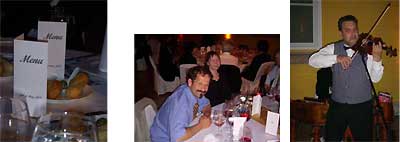
On the second evening, the NESTet Conference Dinner took place at the Baroque Hall of Budapest’s Historical Museum, which is situated in the Royal Palace of the Castle of Buda. The Baroque Hall provided an incredibly beautiful setting for the dinner and an opportunity for colleagues from all over the world to socialise. The dinner guests were entertained by a band playing traditional Hungarian music and served a delicious dinner in an unforgettable atmosphere.

On the final day of NESTet 2008 participants took part in one of two technical tours: the first was a visit the Paks Nuclear Power Plant; the second was a trip to the Budapest Research Reactor at the Central Research Institute of Physics and to the Training Reactor of the Budapest University of Technology and Economics. As a Young Generation reporter, I visited the Paks NPP and found the excursion very interesting. In my opinion, this fascinating and informative visit was a perfect ending to a perfect conference.
Working as a Young Generation Network reporter at NESTet 2008 was a wonderful experience for me personally. I met numerous new people and had extremely interesting discussions - both about their nuclear industries and their cultural and educational backgrounds. Attending the conference gave me an opportunity to learn more about the nuclear industry in various countries, as well as about the current challenges that the industry is facing world wide.
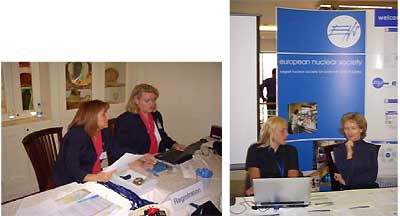
I am very grateful for having been given the opportunity to attend this conference. I am sure that all the other participants share my feelings about how well ENS organised the event. I am also confident that they share my view that this conference is extremely important and that we need to focus continually on education and training in the nuclear field. This debate will doubtless continue intensively over the next two years and at the next NESTet conference.
On behalf of myself, the Young Generation network and participants at NESTet 2008 I would like to thank ENS for making this conference such a success.
Helin Sanna
TVO OL3 Project
Teollisuuden Voima Oyj
27160 Eurajoki
Finland
sanna.helin@tvo.fi
http://www.euronuclear.org/e-news/e-news-21/pime2009.htm


Make a note in your
diary now…. PIME 2009 will take place from 15 to 17 February 2009
in
We would also like to take this opportunity to launch the PIME Award for Communications Excellence, which was won this year by our friends in the Netherlands for their excellent communications campaign on the radioactive waste management facilities at COVRA.
The deadline for sending in your entries for the 2009 PIME Award for Communications Excellence is 15 November 2008.
![]() download
PIME Award entry form.
download
PIME Award entry form.
Following the success of this year’s new selection process it has been decided to repeat it next year. All entries to the competition will first be judged by a jury made up of nuclear communications specialists, who will then draw up a short-list of the best entries. The short-listed candidates will have the opportunity to present their campaigns at PIME 2009 and Pimers will then be invited to cast their vote to determine the overall winner. It’s all about peer recognition and appreciation.
For further information about PIME 2009 please contact
Pime 2009 Conference Secretariat
http://www.euronuclear.org/e-news/e-news-21/rrfm2009.htm


The ENS Research Reactor Fuel Management Conference is the best place to exchange knowledge and experience about research reactors! Each year an impressive number of actively involved stakeholders attend this conference.
We hope you will join us next year in Vienna!

Some four hundred Boiling Water Reactors (BWR) and Pressurized Water Reactors (PWR) have been in operation for several decades. The present concept, the High Pressure Boiling Water Reactor (HP-BWR) makes use of the operating experiences. HP-BWR combines the advantages and leaves out the disadvantages of the traditional BWRs and PWRs by taking in consideration the experiences gained during their operation. The best parts of the two traditional reactor types are used and the troublesome components are left out. The HP-BWR major benefits are;
1. Safety is improved; -Gravity operated control rods -Large space for the cross formed control rods between fuel boxes -Bottom of the reactor vessel without numerous control rod penetrations -All the pipe connections to the reactor vessel are well above the top of the reactor core -Core spray is not needed -Internal circulation pumps to assure hydrodynamic stability.
2. Environment friendly; -Improved thermal efficiency, feeding the turbine with ~340 0C (15 MPa) steam instead of ~285 0C (7MPa) -Less warm water release to the recipient and less uranium consumption per produced kWh
3. Cost effective, simple; -Direct cycle, no need for complicated steam generators -Moisture separators and steam dryers are inside the vessel and secondary separators and dryers can be installed outside the reactor vessel, inside or outside the containment -Simple dry containment
Now the time has come to move a step further and develop an improved type of power reactors. Common sense, public confidence and economic considerations demand that this new design should not be a big leap from the presently functioning machines, however it should be a significant improvement. Therefore it is important to avoid those parts of the older designs which caused trouble in the past e.g. PWR steam generators, BWR perforated reactor vessel bottoms and instead rely only on a stable construction with proven components which served well in the past. The High Pressure – Boiling Water Reactor (HP-BWR) attains these goals, by using the PWR; pressure vessel, the electro-magnetic control rod operator and the BWR; core internals, circulation pumps and steam and moisture separators.
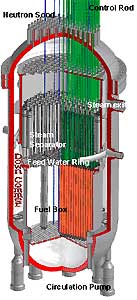
Figure 1. The High Pressure Boiling Water Reactor
The control rods are gravity operated as this system served well in PWRs. However here the form is like a cross, as it is in the BWRs. This assures large space for the cross formed rods between the BWR type fuel boxes.
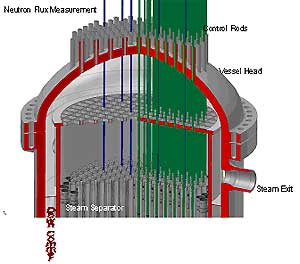
Figure 2. Reactor vessel head and reactor internals
The bottom of the reactor vessel now is without numerous control rod penetrations a great advantage compared with the previous design
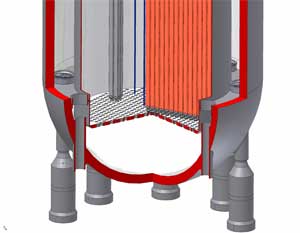
Figure 3. The bottom of the reactor vessel and circulation pumps
All the pipe connections to the reactor vessel are well above the top of the reactor core. This means that a pipe break would not empty the reactor vessel. Therefore core spray is not needed.
Internal circulation pumps are used to assure hydrodynamic stability. This way the orifices at the fuel channel inlets are chosen so that the one phase pressure drop will dominate over the two phase pressure drop to avoid hydrodynamic oscillations. By applying natural circulation one could omit the circulation pumps, however the margin to avoid hydrodynamic oscillations would be diminished.
Compared with the traditional BWR the HP-BWR has further advantages;

Table 1. Comparison between BWR and HP-BWR
due to the high temperature, improved thermal efficiency and due to the increased negative power reactivity coefficient further improved inherent stability.

Figure 4. Long term stability without the use of any control system.
Inherently stable reactor
Improved thermal efficiency is assured by feeding the turbine with ~340°C (15.5MPa) steam instead of ~285°C (7MPa). The Carnot cycle theoretical efficiency (THot - TCold )/ THot is for BWR ~46% and for HP-BWR ~51% at TCold = 300 K. This demonstrate the advantage of the HP-BWR which utilizes the fuel more efficiently and releases less warm cooling water to the environment per produced kWh
The HP-BWR operates in direct cycle mode, no need for complicated and expensive PWR steam generators and the very complicated BWR reactor pressure vessel bottom. Moisture separators and steam dryers are inside the pressure vessel and secondary separators and dryers can be installed outside the reactor vessel, inside or outside the containment. The containment is a simple dry containment which allows easy entrance and inspections and also minor repairs during operation.
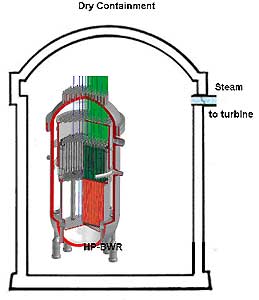
Figure 5: HP-BWR in a dry containment
Thanks to Hernan Tinoco of the Forsmark NPP and Joanna Peltonen of KTH for their valuable support.
ENS News, October 2007, Proceedings of the European Nuclear Conference (ENC) 2007, Brussels
http://www.euronuclear.org/e-news/e-news-21/NUSIM-2008.htm

It’s hard to believe... but the 16th NUSIM (NUclear Seminar and Information Meeting) is already history. Only the more mature members will remember the first editions of this well-established conference. In fact, the first NUSIM took part in 1992, in Plzen (the Czech Republic, although at that time it was still Czechoslovakia). It is an annual conference organized jointly by the Czech, Slovak and German Nuclear Societies.
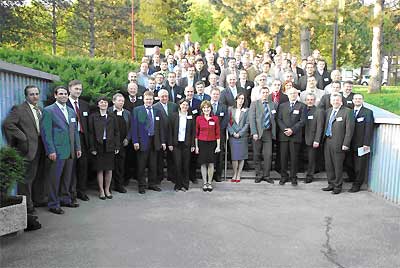
After the first NUSIM in Plzen, the subsequent meetings have taken place in the following cities:
1993 - Isar (Germany),
1994 - Piestany (Slovakia),
1995 - Praha (Czech Republic),
1996 - Obrigheim (Germany),
1997 - Levice (Slovakia),
1998 - Trebic (Czech Republic),
1999 - Erlangen (Germany),
2000 - Casta (Slovakia),
2001 - Ceske Budejovice (Czech Republic),
2002 - Dresden (Germany),
2003 - Bratislava (Slovakia),
2005 - Tabor (Czech Republic),
2006 - Levice (Slovakia) and
2007 - Liberec (Czech Republic).
At this year’s conference, that took place on 24 & 25 April, 118 members of the organizing nuclear societies, participants from the three organizing countries, guests from the European Commission, Austria, Hungary, France and Italy convened at the mountain holiday resort of Casta Papiernicke, which is used by the Slovakian Parliament.
A series of presentations were given during a number of sessions. The sessions covered a range of topics such as: the outlook for nuclear power in the EU and neighbouring and partner countries; maintenance, service and engineering strategies; new reactor units for Europe; the modernization of NPPs; safety upgrading; decommissioning, radioactive waste management and environmental impacts and presentations of young generation.
During the plenary session, guest speakers described current nuclear energy policy in Slovakia (Jozef Tomek), Germany (Reinhard Heck) and the Czech Republic (Ivo Kouklik). In addition there was a presentation about the prospects for nuclear power in Hungary (Tamas Pazmandi) and about the struggle to maintain nuclear knowledge in an antinuclear environment in Austria (Helmut Boeck). Marc Deffrennes from the European Commission’s DG Research gave an impressive overview of EU energy policy and of research and training initiatives in a broader context.
In total, 29 presentations were given by experts on current state-of-the-art provisions for nuclear education, research, industry, health care, power plant operation and waste management. Everyone was focused on achieving one common goal – promoting the peaceful use of nuclear energy by using human skills and expertise to ensure protection against ionizing radiation and by operating nuclear power plants that offer economically efficient electricity production while at the same time protecting the environment.
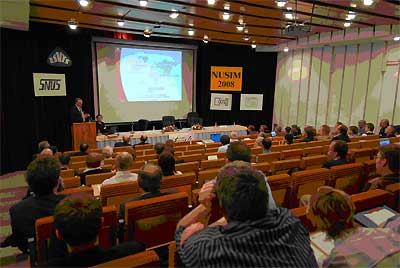
Many thanks should go to all those who presented papers at NUSIM 2008. They contributed to the conference’s high level of professionalism. The presentations indicated that there is a reawakening of the European nuclear industry, with policy-makers trying to keep pace. The subject of decommissioning and radioactive waste management have always been and will remain very important and in the years to come. This is especially true for Slovakia, which faces the shutdown, in December 2008, of the second unit at its NPP V-1. This will inevitably play even more central role in the sustainable development of nuclear power.
Graduate and post-graduate students from the national Young Generation sections demonstrated that in spite of the global lack of young specialists in the nuclear science field, there is still a glimmer of hope that the next generation of experts is already taking shape at universities today.
After a full day of presentations and discussions participants had an opportunity to visit the construction site of Units 3 and 4 at Mochovce NPP and the Slovakian radioactive waste repository at Mochovce.
Feedback received from NUSIM participants was unanimously positive and this was not simply because of the lovely gala dinner after Day 1 of the conference! Many participants are doubtless already looking forward to NUSIM 2009, which will take place in the Czech Republic.
Vladimir Slugen (SNUS), Václav Hanus (CNS), Konstantin Jacoby (KTG)
http://www.euronuclear.org/e-news/e-news-21/MINA-2008.htm

CIEMAT is Spain’s Public Research Agency and a recognised centre of excellence renowned for its work in the field of energy and environment. It is also a hotbed for the development of various cutting edge technologies. Since its creation in 1951, education and training in the nuclear field has been a CIEMAT priority. To help it achieve this goal, the Institute for Nuclear Studies was created in 1964 and since its inception a major initiative that was launched was the originally named “Course of Nuclear Engineering.” This course has received considerable acclaim both at home and abroad. Over the years it has adapted its course content and format to fit the evolving national and international nuclear trends.
Inspired by the “nuclear renaissance” and driven on by the challenge of preserving nuclear knowledge and expertise and the bases that support the European Education Area, it was decided that CIEMAT’s nuclear education and training portfolio should adopt a radically new approach. This review project was baptised MINA-2008 (Máster en Ingeniería Nuclear y Aplicaciones). This paper outlines the major characteristics, developmental phases and mechanisms that underpin MINA-2008.
MINA, thanks to a “project driven” approach, intends to build a bridge between university education on the one hand and technical capabilities demanded by today’s nuclear industry and organisations on the other. In short, a training package that provides participants with the real skills needed to fit the demands of the nuclear sector.
Four major design bases support MINA:
Professional orientation: emphasis is put on familiarisation and training in the latest nuclear engineering methods and technologies currently being applied.
Entire scope: Masters’ students will be provided with an official academic degree that is recognised by several national universities and, at the same time, will help them gain their first foot on the employment ladder.
Integration policy: the Spanish nuclear sector (electricity companies, vendors, fuel manufacturers, regulators, the waste management agency, academia and research centres) is deeply involved in all aspects of MINA. Suffice to say that at the top level of MINA, an Advisory Committee of the Masters’ Management Board has been set up at the heart of the Spanish R+D Technological Platform on Fission Nuclear Energy (CEIDEN).
Excellence in “Mastering:” Contributions from academia, industry and research institutes will be balanced and consistent with accepted experience and expertise in the fields covered by MINA.
According to the agreed schedule, the first MINA “package” will be the course offered in 2008-2009.
L.E. Herranz, J.C. García-Cuesta, S. Falcón,
M. Marco
Centro de Investigaciones Energéticas MedioAmbientales y Tecnológicas
(CIEMAT)
Avda. Complutense, 22 28040 Madrid
Tel: 91 346 62 19 Fax: 91 346 62 33
e-mail luisen.herranz@ciemat.es
http://www.euronuclear.org/e-news/e-news-21/kozloduy.htm

The Kyoto Protocol, which was signed in December 1997 in Kyoto, Japan, under the auspices of the United Nations, was the political beginning of the process for limiting and reducing the emitting of greenhouse gasses into the atmosphere. For the first time in the world the Clean Development Mechanism is being implemented with the objective of investing in environmental projects that reduce greenhouse gas emissions in developing countries. The financing of these projects is provided through the punitive sanctions imposed on industrialized countries and countries in transition, including Bulgaria, which are in breach of their Protocol commitments.
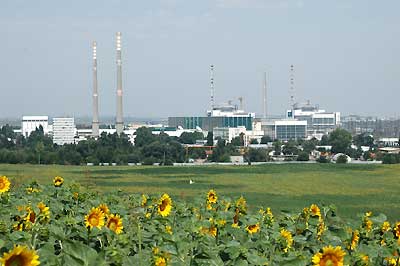
With regards to the process of Bulgaria’s accession to the European Union, the World Bank has estimated that the environmental protection costs to be paid by our country, by the year 2015, will amount to 6,1 - 8,6 billion €. Part of these costs result from the country's commitment to reducing its greenhouse gas emissions, the main source of which are conventional fossil-fired plants and vehicles that run off organic fuels.
One of the fundamental components of Bulgaria’s economic competitiveness is the development of cheap and clean electricity. Today, this is impossible without nuclear power’s environmentally friendly profile and virtual inexhaustibility. The shutting down of the first four units at Kozloduy NPP, with the environmental consequences that this decision provoked in different regions of our country, underlined the truth of this statement.
Our NPP, the only one in operation for the time being, employs a WWER (Water – Water Energetic Reactor) first and second generation reactor type that is analogous to a PWR type (pressurized water reactors) reactor that is widely used in Western countries. Its units have been operating for more than 100 reactor years and over that period they have proven their operational reliability and safety as a source of cheap electricity providing the main base load for the country’s electricity grid.
Nevertheless, at an early stage of reactor design the “small” units (WWER-440/ V230) demonstrated a number of innovative solutions, which provided a basis for the design of the next generation of reactor units.
The design of the reactor unit incorporated a number of design and engineering solutions that ensured its "interior self-protection" and provided a high level of plant safety and reliability. These were as follows:
a high level (to maximum design safety margins) of reactor core thermal reliability
high reliability of the reactor with regards to possible deviations from basic operational parameters (self-regulation)
stable natural circulation of primary coolant, allowing removal of up to 9% of the reactor thermal power in emergency modes
a high level of redundancy of heat removal system – 6 circulation loops
a large water reserve in the steam generators, allowing long-term residual energy removal without feed/after reactor shutdown
use of high-strength steel for the reactor pressure vessels
use of high plastic-stainless steel for the primary equipment and pipes, which allows the application of the “Leak- Before Break” principle
two turbine generators, which allow continuous operation at power rate different from the nominal rate
The advantages of the Kozloduy reactors are best described by Western European Nuclear Regulator’s Association (WENRA) in its report of 1999. “…When assessing the safety of a WWER-440/230 nuclear power plant it should be pointed out that these reactors similar to all WWER 440 reactors feature intrinsic safety parameters surpassing those of the modern western NPPs.
…The amount of coolant per megawatt is two times than the amount of coolant in any western NPP.
… These safety parameters provide efficient protection against potential deteriorating of the most transients into more severe accidents.”
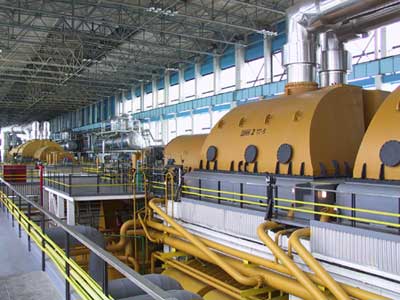
The NPP is a capital-intensive installation – approximately 2000€/megawatt generating capacity. Experience in the developed nuclear countries has shown that the continuous operation of reactors, under guaranteed safety conditions, is cost-efficient - costing approximately one tenth of the initial investment. The WWER – 440 Model 230 reactors, which have been installed in Russia, have already been granted a license for the extension their operational life time for a further 15 years after modernization.
In 2002 the International Atomic Energy Agency (IAEA) visited Bulgaria in order to review the implementation of recommendations for the design of “small" units. Based on its review of the results the IAEA team declared that the operational and design safety of Units 3&4 at Kozloduy NPP were in compliance with the safety standards achieved by the plants of the same generation. They also reported that most of the measurements carried out exceeded the scope of recommendations made for the plant design, operation and seismic performance, and that the plant personnel was highly qualified and personally committed to the improvement of operational safety. This constituted a guarantee for the continuation of this trend. This disproved the claim made by the experts from G-group that such units “can not be modernized” at a reasonable cost.
Bulgaria, with its well established traditions and culture, human potential, natural resources and production capacities, is already a full member of the European Union. Kozloduy NPP is the pearl of our power sector, thus our country ranks deservedly with developed nuclear countries that ave advanced electricity generation technologies. The plant’s long-term operational safety gives good grounds for the construction of new nuclear installations.
This is why the Bulgaria Nuclear Society, since it was established, has defended the ''small units" at Kozloduy NPP and has voiced its conviction that it is the duty of every Bulgarian citizen to protect the country's national wealth. There are no sound arguments for the “Mercedes” of our national power sector to be being “kept in the garage” while “Trabants” continue to emit ash and poisonous gases onto the nation’s roads.
All experts in this field, most Bulgarian citizens and most European citizens have been convinced of this for a long time. The time has come to convince European Union politicians as well.
http://www.euronuclear.org/e-news/e-news-21/jk-2009.htm

Every May since 1980, the Annual General Meeting on Nuclear Technology (Jahrestagung
Kerntechniek) has been organized by the Kerntechnische Gesellschaft e.V.
(KTG) and the Deutsches Atomforum e.V. (DAtF). Each AGM has taken place at
a different city in Germany.
This year’s meeting, which was held from May 27 to 29, in Hamburg, was attended by nearly 1400 participants from 23 countries. They included politicians and representatives from industry, science, and the research community.
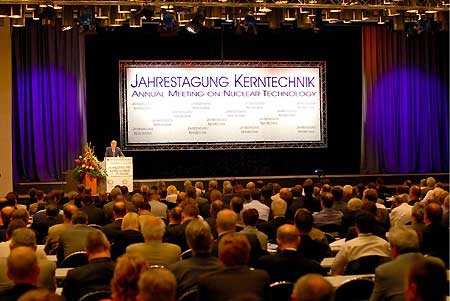
In his welcome address, the president of the Deutsches Atomforum, Dr. Walter Hohlefelder, underlined that the special approach adopted by Germany with regards to nuclear energy will lead to an impasse that will hold up the progress of German energy policy.
Herlind Gundelach, president of the Office for Science and Research of the Free and Hanseatic City of Hamburg, and Joost de Jager, Secretary of State for Science at the Ministry of Science, Economy, and Transport (Schleswig-Holstein, Kiel) gave opening addresses on behalf of the host city.
Presentations were then made by Ulrich Gräber, AREVA NP GmbH, Erlangen; Dr. Hans-Josef Zimmer, EnBW Energie, Baden-Württemberg AG, Karlsruhe; Fang Chun Fa, Daya Bay Nuclear Power Operations and Management Co. Ltd., Shenzhen, PR China; Osamu Maekawa, Power Systems Company, Toshiba Corporation, Japan; Dennis R. Spurgeon, Assistant Secretary for Nuclear Energy, Department of Energy, Washington D.C., USA and Guido Rettig, TÜV Nord e.V. and VdTÜV, Hanover.
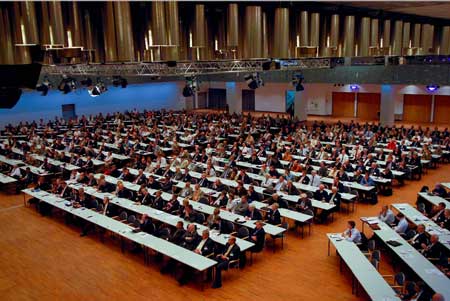
The traditional guest lecture was given by Professor Dr. Albrecht Wagner of Deutsches Elektronen Synchrotron DESY, Hamburg. The subject of his speech was The European X-Ray Laser XFEL.
The plenary session concluded with a word on behalf of the KTG chapter of the Young Generation Nuclear from Cora Fischer, and by a closing speech from KTG Chairman, Dr. Peter Fritz.
This year, within the framework of the Jahrestagung Kerntechnik, another nuclear energy campus was organized for young nuclear researchers. Six “technical expert sessions” were also organised by the KTG Expert Groups. Furthermore, a total of 49 companies had stands at the accompanying exhibition.
After the meeting a concert was given by Camerata Nucleare.
All the presentations given at the Jahrestagung Kerntechnik will be published in the Forum's magazine, ATW. In the meantime, all presentations can be downloaded from the following web address: www.kernenergie.de/r2/en.
The 2009 Annual General Meeting on Nuclear Technology will take place in Dresden, from May 12-14.
Joachim U. Knebel – KTG
http://www.euronuclear.org/e-news/e-news-21/bnes.htm


The following report on was written and compiled by Michael Grave, Vice President of BNES.
Learned Society activity in the UK has been led by the British Nuclear Energy Society since 1962. Our sister organisation the Institution of Nuclear Engineers is a professional body whose principal aim is the promotion of the highest standards of professional practice and knowledge in nuclear engineering. Admission procedures ensure that members maintain these high standards and membership of the Institution confers a hall mark of professional standing. The additional hallmark of ECUK Registration, with the designations of Chartered Engineer, Incorporated Engineer or Engineering Technician can be conferred on those members who fulfil the appropriate requirements.
Over the years the two organisations have collaborated and grown closer thanks to a joint journal, secretariat, branches and conference sponsorship. Informal discussions with key stakeholders have shown that the formation of a Nuclear Institute would be widely regarded as a beneficial step.
BNES and INucE Trustees agreed a Memorandum and Articles of Association for the Nuclear Institute (NI), which was then incorporated as a company limited by guarantee with Companies House on 23 April 2008. BNES and INucE organisations continue to function as normal and the duties of the existing Trustees remain in place. No assets will be transferred until the respective Trustees and members of BNES and INucE have considered and agreed to the proposed merger, if they so do. This is scheduled for September 2008.
To celebrate the first step an event took place at the House of Commons to which a number of key stakeholders from Government, Industry and education were invited. The event was hosted by Linda Gilroy MP and Malcolm Wicks, Minister for Energy, gave a positive speech in response to the opening address by John Earp the current BNES President. The drinks reception was followed by dinner hosted by David Whitworth the current Institution of Nuclear Engineers President at which Paul Thomas, the President designate for the Nuclear Institute gave his views on the future of the industry, which was well received. Common ground in the UK is so important because of the resurgence of interest in all aspects of nuclear energy; clean up; a major political turn around in the requirement for new build and the need to service and extend the life of the UK’s existing nuclear facilities.
This report on the recent Nuclear New Build Conference was written by Andrew Howarth of the UK’s vibrant Young Generation Network (and Nexia Solutions Ltd).
A keynote address by John Hutton the Secretary of State for Business, Enterprise and Regulatory Reform (BERR) stated the Government’s unequivocal support for nuclear power as a part of a balanced energy policy, as detailed in the Energy White Paper that is currently passing through the legislative process unopposed and which is expected to receive the Royal Assent very soon. This was followed by sessions covering regulatory aspects, financial and legal aspects, the UK delivery model, the UK supply chain and skills, fuel cycle and waste management, and public acceptability. The conference closed with a very positive speech from Adam Dawson, a senior civil servant at BERR, which reflected the message contained in John Hutton’s opening address.
One session that was particularly relevant to the YGN and younger industry members in general was the UK supply chain and skills, chaired by Andrew. The session consisted of four presentations followed by a lively panel discussion. Bill Bryce, director of Doosan Babcock and representing the Nuclear Industry Association, presented the findings of the NIA review of UK capability to deliver a new build programme. Jean Llewellyn, Director of National Skills Academy, Nuclear, gave a presentation on the skills and training initiatives that are currently in place across the industry, and what is still required. Gerry McGill, Managing Director of AMEC Nuclear, presented his view of models of partnering relationships that are essential for successful delivery of new build construction. Finally, Dougie Rooney, National Officer of Unite, spoke passionately about the need for unions and industry to work together. Overall, the panel provided a positive view of the UK supply chain and skills, but highlighted the important factors that need to be concentrated on in order for the UK to provide confidence to investors of the ability to succeed.
Skills development and availability is vital to the activity of the industry, regulators and supply chain to deliver all aspects of the UK’s forward nuclear programme. Very significant in 2008 was the formal launch of the National Skills Academy, Nuclear at the Science Museum in London sponsored by BNES when an Apprentice of the Year Award was announced by John Earp, BNES President. BNES Education and Training Committee chaired by Michael Grave (Doosan Babcock, BNES VP & ENS Board Member) plays a prominent role in steering and supporting E&T initiatives. It supports a number of initiatives aimed at rectifying this. In parallel activities to support schools, (Energy Foresight), university courses, attendance at premier industry summer schools such as the World Nuclear University and Joliot/Hahn, a significant grant to the Royal Academy of Engineering and then involvement of young professionals in the industry has also been progressed.
It is not surprising that all this enthusiasm for the future
has had a significant impact on the growth of BNES membership – see
the graph below. This increase reflects many things including activity levels
within the sector, future prospects for the industry and the promotional
work carried out by the active volunteers within the BNES. It is particularly
pleasing to note the year on year increase of YGN members within the BNES
as this indicates a successful future for the nuclear sector in the UK. The
increase in membership has also enabled the establishment of five new branches
in recent years.
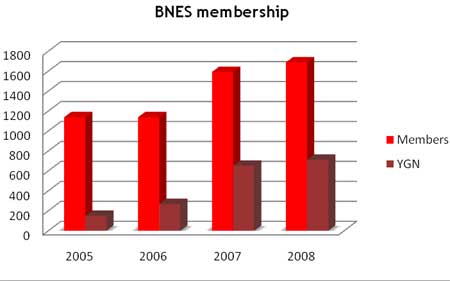
So the Joint Transition Group set up by BNES, the INucE and the Trustees designate for the Nuclear Institute are working hard to bring together a common voice for nuclear energy and engineering in the UK.
1 This works on the number of members paid at the end of each year (not including 2008)
Nuclear Decommissioning: from safe operation to site remediation
ACC Liverpool
22 -24 September 2008
www.decom08.com
5th International Conference on Low Dose Radiation (co-sponsored
by ENS)
The Think Tank, Birmingham
3 - 5 February 2009
www.ldr09.com
Radioactive Materials Transport
Lowry Hotel, Manchester, 12-14 May 2009
www.ramtransport09.com
Michael Grave, Vice President of BNES
http://www.euronuclear.org/e-news/e-news-21/senda.htm

The SNE magazine analyzes the results of the nuclear power plants in 2007 |
The Spanish Nuclear Society (SNE) held its annual meeting entitled Operating Experiences of the Spanish Nuclear Power Plants last year. Nuclear España, SNE’s magazine, has just published its special annual issue featuring the experiences and performance of all Spanish NPPs in 2007. This bilingual (Spanish-English) issue also features production figures and a report on the main activities carried out during 2007. Also included are speeches made by Pedro Rivero, the President of UNESA (the Spanish electric utility employers’ organization), and Carmen Martínez Ten, President of the CSN (the Spanish regulatory body).
In 2007, the nuclear power plants generated 18% of total electricity production. Also of note last year was the approval of the law regulating the CSN. This is highlighted by CSN’s president in his speech in this special issue.
In addition to the sectorial reports, there was also a speech made during the meeting by the Vice President of the association of large consumers, Javier Penacho, who called for a true liberalisation of the energy supply market as an indispensable requirement for maintaining the competitiveness of the Spanish nuclear industry.
Nuclear España publishes eleven issues a year. In 2008, the topics to be discussed are: R&D in nuclear fuel, physical security, operating support, nuclear power plants in 2007, safety management, communications in the nuclear sector, long-term operation, dismantling, and training. In addition, the traditional issue on the Directory of Companies and Products and the report on the Annual General Meeting will also be published.
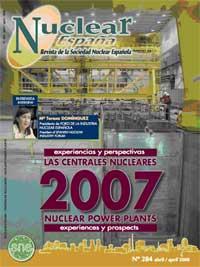
Last February, the Spanish Nuclear Society held its Annual
General Assembly, during which the activities carried out during 2007 and
those proposed for 2008 were presented.
The actions approved for 2008 include the preparation of the SNE Strategic
Plan, which will analyse the current situation of the Society in Spain and
worldwide and propose actions aimed at supporting the SNE at a time of change
and revival of nuclear power.
The General Assembly also approved the 2008 budget and the replacement of one of the members of the Board of Directors - the new board member is Jesús Sánchez Álvarez-Campana.
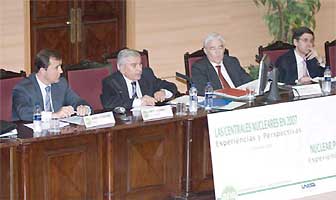
The 34th Annual General Meeting of the Spanish
Nuclear Society will take place in the city of Murcia, located in southeastern
Spain, near the coast, from October 29 - 31, 2008.
This meeting has become the meeting point for the industry’s professionals
and companies. More than 500 delegates will gather in Murcia to exchange professional
experiences and participate in a technical programme consisting of two plenary
sessions and 25 technical sessions devoted to the most relevant issues.
In addition, the social programme will feature activities designed to enable participants to enjoy the countryside and traditional gastronomy of the region of Murcia.
For more information on the 34th Annual Meeting of the SNE, see www.sne.org.es.
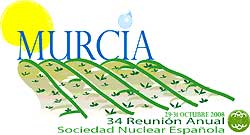
http://www.euronuclear.org/e-news/e-news-21/myrrha.htm


SCK•CEN (the Belgian Nuclear Research Centre) is a candidate for hosting a European fast spectrum experimental facility for demonstrating efficient transmutation and associated technologies using a system that works in sub-critical and/or critical mode. With this in mind, SCK•CEN started, in 1998, designing the MYRRHA facility as an accelerator driven system (ADS) with the following objectives:
To demonstrate ADS technology, full-scale, within the framework of research into the transmutation of high-level waste
To serve as a flexible fast spectrum irradiation facility for testing materials and innovative fuels for ADS and GEN IV systems and fusion reactors
To contribute to the technological demonstration of the GEN IV Lead Fast Reactor
To perform fundamental and applied physics research making use of SCK.CEN’s high power proton accelerator
MYRRHA should be operational in 2020 and is designed as an open user facility for the international research community in the fields of physical science, waste transmutation, nuclear engineering, radioisotope research and production, as well as for material and nuclear fuel science.
Since the start of the FP6 EUROTRANS integrated project launched by the European Commission in 2005, MYRRHA has served as a basis for a small-scale, short-term experimental facility demonstrating the technical feasibility of “Transmutation in an Accelerator Driven System (XT-ADS)” machine. The main parameters and characteristics of the MYRRHA facility are as follows:
The MYRRHA accelerator is based on LINAC technology in order to fully demonstrate the industrial scale ADS and to meet the very demanding conditions in terms of beam reliability (reduction of the number of beam trips longer than 1 second, up to a maximum of 10 to 20 trips per year)
The windowless spallation target concept of MYRRHA has progressed in terms of design and demonstration on the basis of an important international experimental programme complemented by an international Computational Fluid Dynamics (CFD) effort for the free surface treatment. The evidence of the feasibility of the proposed design is no longer questioned with respect to its fundamental aspect, but some issues still remain open with regards to its fine tuning and advanced design, which will be addressed over the next 3 years
The core maximum sub-criticality level of keff ~ 0.95 assures a comfortable margin for safe operation. The total power ranges from between 50 to 80 MWth (depending on the core loading and the experimental rigs inserted). The total neutron flux levels (1 1015 to 5 1015 n/cm².s) achieved in large irradiation volumes in the core (about 20.000 cm³ in total) enable very high performance testing conditions
The MYRRHA fuel design is based on fast reactor (FR) MOX fuel technology (30% Pu contents) with T91 ferritic-martensitic steel for the cladding and for the fuel assembly wrapper. The inlet temperature is 300°C and the outlet temperature is 380°C. The targeted fuel residence time is 3 years. Nevertheless, the MYRRHA core is designed to accept minor actinide based fuel assemblies whenever these are made available
The primary system of the MYRRHA facility is based on a pool design cooled with Pb-Bi as a primary coolant (see figure 1) and boiling water as a secondary fluid. The heat exchangers and primary pumps are immersed in the reactor vessel in dedicated casings. Interim fuel storage inside the primary vessel can host the used fuel for decay heat before transfer out of the vessel
The MYRRHA building was conceived from the very beginning to take into account remote handling and robotics based operation and maintenance within a controlled atmosphere, limiting the LBE contamination by O2 trapping. The remote handling for both out-of-vessel and in-vessel operation and maintenance was developed using existing and demonstrated technology in the Joint European Torus (JET) fusion facility.
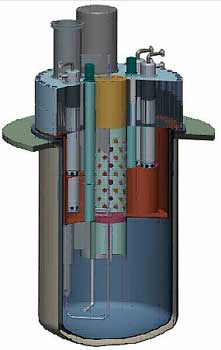
Figure 1: Vertical cut of the MYRRHA/XT-ADS sub-critical reactor
In April 2008, SCK•CEN, together with its European partners, answered a FP7 call for establishing a Centralised Design Team for a Fast Spectrum Transmutation Experimental Facility to be able to work in sub-critical and/or critical mode. Within this framework and starting in 2009, the MYRRHA/XT-ADS design will be updated to allow for critical mode operation. The partners involved are the following research organisations: CEA (FR), CNRS (FR), FZK (DE), FZD (DE), CIEMAT (ES), ENEA (IT), NRG (NL) and ITN (PT). From the nuclear industry the partners involved are: Ansaldo Nucleare (IT), Del Fungo di Giera Energia S.p.A. (IT), AREVA NP S.A.S (FR), Empresarios Agrupados (ES), SENER (ES), ADEX (ES), OTL (UK) and CRS4 (IT). Also involved are two universities: UPM (Spain) and UPV (Spain). Since the MYRRHA project is moving to an industrialisation phase, the partners leading the major work-packages are from the nuclear industry.
The MYRRHA project (technical description and business plan) has been submitted to the Belgian minister of energy with a request for financial support for a significant part of the cost of the initial engineering phase of MYRRHA and for its final realisation at a later stage. As a result, in the governmental agreement signed by the new "Leterme I" Belgian federal government, which was formed in March 2008, support for the MYRRHA project is regarded as an international research infrastructure that serves research programmes looking at the reduction of long-lived waste and the production of radio-isotopes for medical applications. Currently, SCK•CEN is in discussion with the Belgian government to set the specific requirements and conditions of this support.
A detailed business plan for MYRRHA exists (MYRRHA Project – Business Plan 2007, SCK•CEN Report, reference ANS/HAA/DDB/3900 B043000/85/07-17, April 2007). From the plan it is possible to identify a total investment cost, expressed in 2007 values and spread over 12 years, of ~700 M€. The operational costs are estimated to be 38 M€ per year.
The 2007 R&D programme for MYRRHA at SCK•CEN features various highlights. Here are some of them:
The primary and secondary system component configurations were further elaborated and optimized. The system components were calculated in detail. The diaphragm separating the hot and cold lead-bismuth coolant in the reactor vessel was largely simplified. This new configuration of vessel components resulted in an enhanced capacity for natural circulation in emergency situations. The specifications for the experimental devices (in pile sections) were formulated according to the MYRHA/XT-ADS objectives and adapted to the actual core and core support structure design
The neutronic calculations for MYRRHA/XT-ADS were mainly focused on two topics. Firstly, the estimation of the neutron induced damage (dpa) on the core barrel and top grid. This led to a recommendation to increase the core by two extra rows, thereby increasing the space between the last row of fuel assemblies and the core barrel. Secondly, calculations were performed to estimate the neutron fluxes in the eight in-pile-positions. In addition, scoping calculations for a burn-up cycle and reshuffling scheme were made
The issues of vacuum and lead-bismuth conditioning for the windowless spallation target were addressed through dedicated experiments, including experiments simulating the proton beam surface heating with an electron beam (WebExpIr). It was shown that the high intensity heating has no distortive effect on the target surface flow and that the vacuum conditions remain well within the operational limits
One of the fundamental design options is that all maintenance and in-service inspection and repair duties in MYRRHA will be performed by remote handling. In view of this, a first version of the Remote Handling Design Catalogue (RHDC) for MYRRHA/XT-ADS was released. This RHDC provides information and guidance to engineers, CAD designers and technicians with a view to ensuring that the MYRRHA/XT-ADS machine, as well as its remote maintenance system, is designed in a way that is fully compatible with the remote handling requirements. The catalogue contents were finalised in cooperation with Oxford Technologies, taking advantage of their experience with the fully remote maintenance of the EFDA-JET Fusion Tokamak project
Significant progress was made with the development of ultrasonic techniques for visualisation in liquid lead-bismuth under gamma radiation. An acoustic computer model was developed and validated on a mock-up in water. The research to improve the diffusion bonding process to obtain a reliable ultrasonic transducer for application in LBE is ongoing
Material irradiations in stagnant lead-bismuth in the BR2 reactor have been performed to investigate the behaviour of the fuel cladding and structural materials, considered for MYRRHA/XT-ADS, in representative conditions. The samples are being analysed during the course of 2008
As a first step towards the development of MYRRHA the GUINEVERE project was launched and formally accepted by the Governing Council of IP-EUROTRANS, in December 2006. GUINEVERE is a zero-power mock-up of the MYRRHA/XT-ADS with, as its main objectives, the qualification of the sub-criticality monitoring techniques and its role as a validation model for the core neutronic design. GUINEVERE should provide answers to these questions by 2009-2010. To achieve this goal, the zero-power critical facility VENUS facility at SCK•CEN is being adapted to a zero-power lead fast reactor and coupled to a modified GENEPI deuteron accelerator delivering 14 MeV neutrons by bombarding deuterons on a tritium-target
An important milestone reached was the delivery of CEA fuel for GUINEVERE to SCK•CEN, in October and November 2007. Also a derogation to the standard licensing procedures was requested in November 2007. This request was approved by the Minister of Internal Affairs, in March 2008. The construction permit has been received in April 2008. The first phase of the licensing procedure was successfully completed in May 2008.
A full plant layout of the MYRRHA complex has been drawn up on the SCK•CEN technical site at Mol, see figure 2

Figure 2: MYRRHA Plant layout on the SCK•CEN technical site at Mol (BE)
Contacts:
Hamid Aït Abderrahim (hamid.ait.abderrahim@sckcen.be)
Peter Baeten (peter.baeten@sckcen.be)
Didier De Bruyn (didier.de.bruyn@sckcen.be)
myrrha@sckcen.be
www.sckcen.be/myrrha
http://www.euronuclear.org/e-news/e-news-21/eurex.htm

By Costantino BIONDANI (biondani@sogin.it); Michele GILI (gili@sogin.it); Mara MOLLO (mollo@sogin.it)– Sogin Spa
Sogin EUREX Site, str. Crescentino I-13040 SALUGGIA (VC), Italy
At the beginning of 2004, some leakages from the spent fuel pool (SFP), a 675
m3 concrete basin, were discovered at the EUREX (Enriched Uranium Extraction)
pilot reprocessing plant, which was in operation between 1970 and 1983.
Thin cracks in the pool wall caused leakages through the annular space of the pool and from there into the ground. Environmental analyses and radiological measures revealed the limited presence of Sr-90 radionuclide in upper water table samples.
In 2006, Sogin started not only transferring fuel to the nearby Avogadro Fuel Repository, but also draining and purging the pool.
The main steps of involved in this process are described as follows:
Irradiated fuel (a total of 2 tonnes) from the Trino PWR, the Garigliano, according to the following strategy:
Reusing an AGN-1 transport cask with an internal basket modification (6 elements for each cask; a total of 10 fuel transfers)
Loading the cask outside the water, designing a shielded shuttle to move the fuel from the pool to the cask
Transferring the fuel to the nearby Avogadro Fuel Repository, a short distance away (less than 1 km) reduced transport licensing duties.
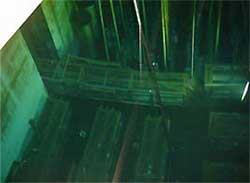
Fuel elements in SFP
Duration: May-July 2007
The maintenance of conventional and radiological safety was achieved by performing the following activities:
• The removal of 300 tonnes crane used for materials handling
• The transfer of AGN-1 cask and accessories from Trino NPP
• The restoration of grates and rails from SFP Area
• The removal of absorption frames used for moving cask AGN-1.
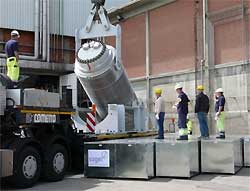
AGN-1 cask loading on trailer
Duration: July 2007
This activity regards the removal of slightly contaminated devices, but not radiating, as for example:
• metallic 'clovers' not removed the previous
year
• quivers containing Trino NPP elements and small baskets
• various devices used in the pool (rods, lamps, television camera)
• foot bridges used for quivers handling during loading fuel
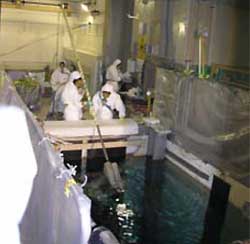
Extraction of metallic 'clovers'
All the activities were performed according to operative procedures for fuel handling and radiation protection.
In particular, the phases involved in managing the waste were:
• the washing of waste in SFP Area
• the removal of waste from SFP Area
• the allocation of waste into appropriate containers
• the transfer to waste to the waste treatment company
Duration: September-November 2007
This activity was the most relevant because it concerned the removal from the SFP of radiating components, such as the headstock MTR (Material Testing Reactors) elements and the magnox capsule.
An Operational Plan was written for the Italian Safety Authority and appropriate shielding and handling frames were designed in order to respect all the laws and regulations for transport and radiation protection.
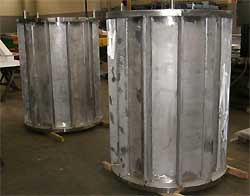
Shielded containers for activated Headstock
MTR
Duration: December 2007; 1 week.
These activities were performed by NUKEM Technology GmbH and ENERGY SOLUTIONS and consisted of the following phases of operational cleaning:
the extraction of various devices from the pool and radiological cleaning and packaging
the sucking out of waste and sludge from the pool bottom
sediment materials recovery from the bottom and the walls of the pool

SIS removal
Duration: November 2007- February 2008; 2 months.
This step consisted of removing and cleaning of plant components and frames that require special disassembly, for example the safety hydraulic System (SIS), the SFP bottom grids, pipes and metallic parts.
Duration: March 2008: 2 weeks.
The purification of the SFP water was performed by two different techniques:
The Wall & Floor WasherTM technique,
by NUKEM/ Energy Solutionsn, an outsourced service
An underwater cleaning system was used to remove contaminated sludge from
the EUREX SFP bottom: about 50 GBq of fission products and transuranic
sludge were recovered.
The Electrocoagulation process, called the SAFETM SYSTEM,
by Energy Solutions, an outsourced service
The water treatment was performed using ElectroCoagulation coupled with
ultra-filtration and final polishing with ionic exchange resins. Water
flow gets through the cells of the system and three chemical processes
occur: coagulation, oxidation and aeration.
Inside the ElectroCoagulation Unit (container ISO 20’) there are
components for water treatment (settling, sludge and feed tanks) that allow
the separation of the sludge from the water.
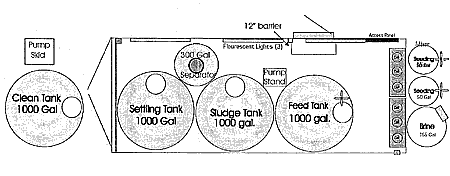
Internal Layout EC System
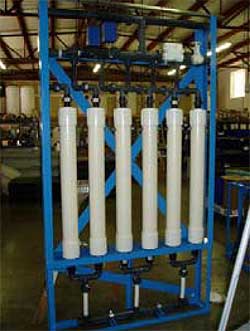
EC cells
Duration: March – June 2008: 4 months.
After accurate radiological monitoring (more than one hundred samples were analysed), water was gradually drained and transferred from the pool to the waste pond (a 1000 m3 external basin).
Surface radiological contamination was limited to pool walls by using specialised painting.
The final water downloading into the nearby Dora river required prior documentation presented to the Italian Safety Authority in order to justify the release levels.
Duration: June 2008: 1 month
Additional steps are scheduled for the following activities:
A SURVEY OF THE CONTAMINATION LEVEL OF THE ANNULAR
SPACE
Radiological characterisation of the annular space, pool frames and ground
below the pool will be carried out
http://www.euronuclear.org/e-news/e-news-21/ygn-reporter-nestet2008.htm


The first NESTet (Nuclear Engineering, Science and Technology – Education and Training) conference was held in Hungary, from 4-8 May. The first three days of the conference took place at the Novotel Budapest Centrum Hotel. Day four was set aside for technical tours.
After opening speeches from David Bonser, President of ENS, and Tamás Pázmándi, Chairman of the Hungarian Nuclear Society, the conference kicked off with the a presentation ceremony for the awarding of European Master of Science in Nuclear Engineering (EMSNE) diplomas for 2007. 11 students from 5 countries received their EMSNE 2007 diplomas.
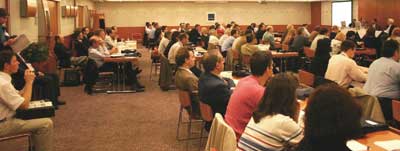
Generally, the programme was divided into two sections - an industry oriented section and an education and training oriented one. The event also featured poster displays that took place on the Monday and on Tuesday, after the lunch break.
The Conference Dinner took place on the evening of the second
day at the Baroque Hall of Budapest Historical Museum, which is situated
in the Royal Palace of the Castle of Buda.
One of the main topics discussed during the conference was the problem of supplying
new professionals for the nuclear industry in the future. While arguments persist
about the role of nuclear energy in the context of future sustainability, a
new generation of scientists, engineers and technicians will, whatever happens,
always be needed to maintain the operation of existing nuclear facilities.
The problem is that in the current uncertain situation it is hard to predict
the future needs of the industry when it comes to recruiting new professionals.
It is also hard to make a career in the nuclear field appear attractive for
youngsters. For example, in Lithuania more than 80% of total electricity generation
is provided by the two units at Ignalina NPP, but now they are to be closed.
This means that after their total shutdown in 2009 a majority of the employees
will be made redundant. Plans to build new units are currently under discussion,
so the knowledge of those professionals who will lose their jobs will be required.
But it will prove a problem to retain these people in the nuclear industry
until that time. On the other hand, to provide the required amount of professionals
universities will have to train a new generation of workers for the nuclear
industry. So, they have to explore what skills and knowledge will be essential
for professionals over the coming years. But even if they produce a detailed
education and training programme the uncertain future of the nuclear industry
at the moment make it hard to persuade youngsters to sign up to a nuclear career.
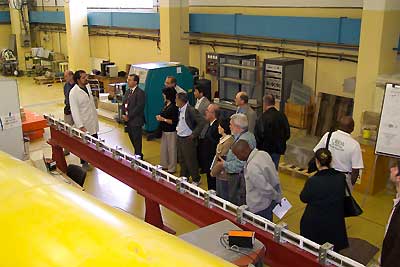
The four-day conference finished with a choice of technical tour - either to the Budapest Research Reactor at the Central Research Institute of Physics (KFKI) or to the Paks NPP. The visit to the research reactor and the KFKI consisted of three parts. First, the leader of the Reactor Department, Sándor Tozsér, outlined the history of the reactor and showed us the control room. Secondly, short presentations about the utilisation possibilities (László Rosta) and research activities (Rózsa Baranyai) were given. The reactor hall was then visited. Next the visitors reviewed the instrumentation and were shown the main parts of the reactor, (it was not in operation at the time because of maintenance works). Finally, the last part of the visit was to the guide hall. Here cold and thermal neutron measurements are carried out with help the neutron guides.
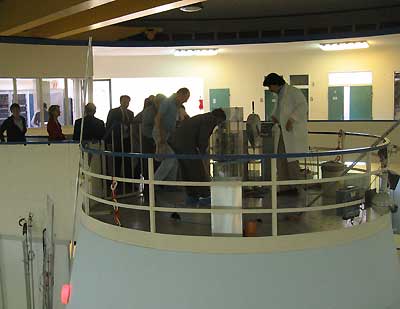
The next stop on the technical tour was the training reactor at the Budapest University of Technology and Economics (BME). We visited the facility during "full operation" with several groups of students given laboratory exercises to carry out such as activation analysis. Our guides, Szabolcs Czifrus and András Csige, started with a short introduction about the history and the objectives of the training reactor. We then had the opportunity to visit the control room and the reactor podium, and to look inside the pool type reactor.
The other group spent the day at the Paks NPP. This tour started at the Simulator Center department, where István Frányó informed them about the training and testing of the main control room staff. He also explained the structure of the main control room simulator. Group Leader Csaba Dohóczki guided the visitors through the turbine hall and to the “visitors’ corridor” of the reactor halls of Units 1 and 2. In the afternoon Péter Lukács took the group round the Maintenance and Training Center, where it received valuable information about the training of primary circuit staff at Paks NPP. Finally, visitors were familiarized with current educational and training practices at the Paks.
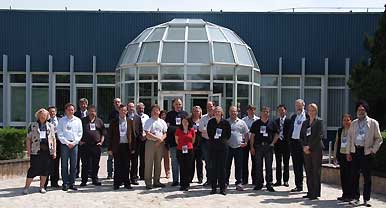
The photos were taken by: Péter Tóth, Attila Madaras, Bogdán Yamaji.
http://www.euronuclear.org/e-news/e-news-21/naygn.htm

280 North American Young Generation Nuclear (NAYGN) members gathered in Chicago recently to attend the 2008 Annual Professional Development Workshop. This year, the central theme of the meeting was Drive Your Success: Train for Tomorrow”. The main focuswere the issues of generational workforce, communications techniques, and knowledge transfer.
The workshop kicked off with a presentation by Chris Crane, Executive Vice President of Exelon Nuclear and Jim Ellis, President and CEO of the Institute of Nuclear Power Plant Operations. Mr. Ellis talked about the positive situation that the nuclear industry is in at the moment. His lecture also identified differences between leadership and management, and how a good manager might not necessarily be a good leader. He added that at this time the nuclear industry needs leadership more than management.
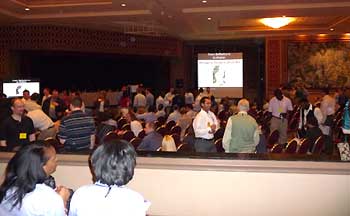
Jack B. Allen, Senior Vice President Operational Excellence Westinghouse Electric Company LLC, discussed how there are different cultures within the nuclear business, and how important is to know and to respect these varying cultures because dealing with people is the foundation of doing business. Even among those that speak the same language there are differences he said: "Americans and British do not speak the same English."
Other speakers clarified the multinational challenge that the nuclear renaissance poses, namely the involvement and interaction of a lot of countries with different cultures. In addition, they stressed how important protocol is in the world of business, for instance, business lunches and dinners are very different affairs for, e.g. Muslims or Japanese businessmen.
The main session of the workshop was chaired by Audrey Nelson, who gave an overview of the situation in North America, where for the first time ever, four (soon to be five) different generations currently work side by side in the same workplace. These are the so-called silent generation, the baby boomers, generation X and generation Y. The main problem with mixture of different generations is the difference in values, and how using new technologies in the workplace is modifying the behaviour and relationships between managers and employees. The session set aside a lot of time for networking and working in groups. Ms. Nelson suggested that generation Y members analyse how they use voicemail and e-mail services compared to a telephone. The main purpose was to point out that the younger generations are losing personal contact by using the new technologies and that they must continue to understand the other generations if they are to succeed.
The workshop ended with a session on knowledge transfer. This focused on how institutions such as NRC are implementing programmes for successfully transferring knowledge. The speakers highlighted how flexibility, above all, was a key to this successful transfer of knowledge. It was also stressed that the word “programme” should not be used within the context of transfer of knowledge as all programmes have their faults and the word implies schedules and knowledge, whereas successful knowledge transfer needs flexibility.
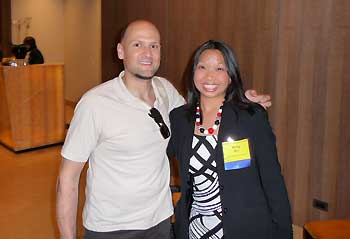
The NAYGN is an association that is made up of chapters all over North America. Any organisation involved in the nuclear industry can start up its own regional chapter within NAYGN and a budget is provided by the founding organisation. For instance, the Pittsburgh chapter is shared by Westinghouse and First Energy active in the region. Nevertheless, some utilities like Progress Energy or Southern Nuclear each have four NAYGN chapters in their organisation due to their locations. Perhaps, this could be the reason why 80-85% of the NAYGN members who attended the conference were members of utilities, while the rest were members of vendors and regulatory bodies.
Based on this experience, it is concluded that American utilities are providing great support for these young professionals. And in return the enthusiasm that this young generation is showing with the new nuclear projects it is involved in in the United States is indeed worthy of admiration.
Miguel Millán, Spanish YGN
http://www.euronuclear.org/e-news/e-news-21/enef.htm

The latest meeting of the European Nuclear Energy Forum (ENEF), took place in Prague (Czech Republic) on 22-23 May. The second meeting of the European Nuclear Energy Forum (ENEF) was officially opened by EU President, José Manuel Barroso, together with Mirek Topolanek, Prime Minister of the Czech Republic; Robert Fico, Prime Minister of Slovakia and Gediminas Kirkilas, Prime Minister of Lithuania.
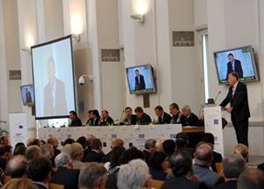
Also in attendance were EU Energy Commissioner, Andris Piebalgs, senior EC officials, MEPs, industry leaders and a broad range of representatives of civil society. The focus of the meeting was the work of the three ENEF Working Groups (WGs) that were established at the first ENEF meeting, in Bratislava (Slovakia), last November, namely the Opportunities, Risks and Transparency WGs.
At the Prague meeting, the chairmen presented synthesis reports on the work of the working groups that were debated by the nuclear forum. FORATOM and the whole nuclear industry have been closely involved in the drafting of these reports. They will be used to determine the main issues that have to be tackled and the appropriate solutions that are required to promote the continued development of nuclear energy in Europe.
The creation of ENEF was initiated by the March 2007 European Council, when Member States suggested “that broad discussion takes place among all relevant stakeholders on the opportunities and risks of nuclear energy.” The Forum’s creation shows that nuclear will now be treated on a level footing with other major energy sources that have had similar forums for some time. Nuclear energy’s contribution, as part of an overall energy mix that includes renewables, to ensuring security of energy supply and combating climate change has now been officially recognised.
ENEF should provide advice to European policy makers, mainly in the European Institutions on: security of energy supply, incentives for investment, EU legislative issues, public opinion, R&D, knowledge management, safety and waste management. It is also expected to work in collaboration with other newly-created bodies the Sustainable Nuclear Energy- Technology Platform (SNE-TP), and the High Level Group on Safety and Waste management (HLG).
The Forum aims to promote an inclusive, transparent and non-ideological debate on nuclear between all the relevant stakeholders. It gathers for the first time a broad range of stakeholders – the nuclear industry, public authorities, the financial community and various sections of civil society.- in a debate on the future of nuclear energy in Europe.
At the first meeting in Bratislava (Slovakia), it was agreed to establish three working groups that are in charge of analysing three main issues: the opportunities of nuclear (financing, competitiveness), the risks of nuclear (safety, waste management, training and education), and information and transparency (better information, trust and confidence/ implementation of the Aarhus convention, best practices). The working groups have already met twice since the Bratislava meeting and are in the process of drafting proposals in order to enable ENEF to provide a roadmap for the continued development of nuclear energy in the European Union. Every working group has created subgroups in order to dwell on specific topics (1).
The Nuclear Forum is taking concrete steps to provide guidelines to help nuclear power contribute to the development of Europe’s low-carbon economy. It is more than ever essential to take part in ENEF in order to shape Europe’s energy future.
http://www.euronuclear.org/e-news/e-news-21/greenhouse-gas-emissions.htm


Every year our friends from FORATOM put together a detailed report on the latest situation with regards to greenhouse gas emission avoidance in the EU. This year’s report was compiled, as always, by Hans Korteweg of FORATOM, and is accompanied by the latest FORATOM position paper on nuclear energy’s contribution to the EU’s Post-Kyoto climate change policy.
For further information please contact Hans Korteweg of FORATOM at: 00 32 2 505 32 24; hans.korteweg@foratom.org
Climate change, resulting from increases in greenhouse gas emissions (GHG), is considered one of the biggest environmental dangers facing the world today. Reducing atmospheric GHG concentrations have become an international priority as evidenced by the signing of the Kyoto Protocol.
Electricity is a clean energy carrier, but to a large extent coal, oil and gas are burned to produce it. In the future, the emphasis in the power generation sector will have to be on cleaner production methods, such as wind, solar, biomass, hydro and nuclear. This change in emphasis will be needed to meet future electricity demand in a way that is low on GHG emissions and compatible with sustainable development objectives.
Nuclear power is the single most significant means of limiting the increase in GHG concentrations in the power generation sector, while enabling access to abundant electricity at a stable and low cost.
Nuclear power, unlike fossil fuel, does not generate GHG directly. For nuclear power and renewable fuels, there are no GHG emissions at the point of generation, but there are releases during the mining and processing of the fuel, construction of the plant, disposal of spent fuel and by-products, and waste management and decommissioning (see Section 3). The emissions from these stages depend, among other factors, on the national mix of electric power production. For example, the GHG emissions from a nuclear fuel cycle are due to the fossil fuel-based energy and electricity needed to mine and process fuel and for the construction and materials of fuel cycle facilities.
The total GHG emissions from electricity production chains vary widely due to the plant characteristics (i.e. type, capacity factor, efficiency, and lifetime) and geographical sitting of the power plant. Recently published studies (see Appendix I) by International Atomic Energy Agency (IAEA), the World Energy Council (WEC) and the OECD’s International Energy Agency (IEA) estimate that on a life cycle basis the emissions intensity of nuclear power is between 2 and 59 tonnes (expressed as tonnes of CO2-equivalent) per GWh of electricity produced (t CO2eq/GWh).
For example, according to a study by the International Atomic Energy Agency (IAEA) in 2000 [1], nuclear energy GHG emissions from the full energy chain (see Appendix I) amount to only about 9-21 tonnes of GHG (expressed as tonnes of CO2-equivalent) per GWh of electricity produced (t CO2eq/GWh), compared to some 385 to 1343 t CO2eq/GWh for fossil fuel chains and 9-279 t CO2eq/GWh for renewable energy chains.
Energy use for fuel extraction, conversion, enrichment and construction / decommissioning (plus materials);
Fuel enrichment by gas diffusion, which is an energy intensive process that can increase GHG releases by an order of magnitude when compared to enrichment by centrifuge;
Emissions from the enrichment step, which are highly country-specific since they depend on the local fuel mix; and
Fuel reprocessing (uranium oxide or mixed oxide), which can account for 10% to 15% of the total nuclear GHG burden.
A calculation has been carried out by FORATOM using the range of total GHG emissions from fossil fuel electricity production chains calculated by the IAEA [1], the IEA [2] and WEC [3] and the latest available electricity generation figures from Eurostat [4].
The following values have been used to estimate CO2eq emissions from the use of fossil fuels for electricity generation. The figures used are at the middle-to-lower end of the range (see Appendix I).
Coal: 960 (g/kWh or tonnes/GWh) |
We can assume, in a hypothetical scenario, in which the EU’s 146 nuclear reactors are removed from the current (2006) energy mix and the individual contributions from all other sources are increased by the
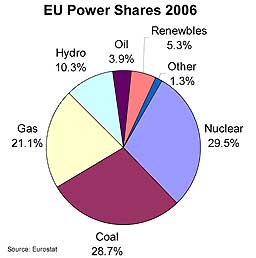 |
same factor (1.49), with the exception of hydropower, to make up for the loss of production and to reach a total generation figure of 3,357,958 GWh. It is assumed that it is unlikely that there could be a significant increase in hydropower capacity in the EU. Two further assumptions are made: zero emissions from other non-fossil sources, such as renewables and nuclear; and no weighting in favour of gas and wind to take into account of a possible increase greater than the factor given above. |
The outcome is a rise in total CO2eq emissions from 1,365 million tonnes to 2,040 million tonnes, the difference being just over 675 million tonnes CO2eq. GHG emissions from electricity generation would rise by 49% if there was no nuclear contribution.
To put the figure of 675 million tonnes into perspective, it can be pointed out that the annual amount of CO2eq avoided by nuclear is equivalent to nearly all the CO2eq emitted each year by the 212.5 million passenger cars currently in use on the EU’s roads (728 million tonnes).
Source: Emissions avoided in 2006 calculated using fossil fuel-emission rates from the IEA, IAEA and WEC and plant generation data from Eurostat.
The overall Kyoto GHG emission reduction target of the EU is approximately 446 million tonnes CO2eq.
Nuclear energy makes a significant contribution to the lowering of carbon emissions from the energy sector in the EU and worldwide. The current use of nuclear energy (accounting for about 15% of the world’s electricity generation) avoids the emission of about 2.1 billion tonnes of CO2eq every year. In the EU as whole, the avoidance levels amount to 675 million tonnes of CO2eq per year, taking into account the current (2006) energy mix. By comparison, the EU has a GHG emission reduction target of 446 million tonnes of CO2eq below 1990 level by 2008-2012. To make savings equivalent to those from the use of nuclear power, all passenger cars in the EU (212.5 million) would have to be taken off the roads. Switching to less carbon intensive or low carbon fuels such as gas, nuclear and renewables will play a major role in reducing emissions.
http://www.euronuclear.org/e-news/e-news-21/position-paper.htm

|
FORATOM, as the voice of the nuclear industry in Europe, makes the following main points in view of the upcoming discussions on a ‘post-2012’ international climate regime. FORATOM believes:
When addressing climate change, we encourage policy-makers to consider zero and low emitting electricity generating technologies, including nuclear energy.
The nuclear power sector can play an even greater role in greenhouse gas abatement through the construction of new nuclear plants, plant lifetime extensions and plant upgrades. The Intergovernmental Panel on Climate Change (IPCC) believes that nuclear should continue to play an important role in the overall effort to curb greenhouse gas emissions in the decades to come1.
Nuclear energy should not be penalised in policy mechanisms designed to help address climate change, as it has been in CDM and JI projects and the EU’s Linking Directive. All technologies that can help fulfil the purpose of the CDM and JI, as defined in the protocol, should be eligible for use in those mechanisms.
The time frame of policy cycles concerning climate change do not coincide with that of the energy sector in which an investment decision is made on a mid- to long-term basis. Current obligations under the Kyoto Protocol and EU Emissions Trading Scheme are limited to the 2008-2012 period. The absence of certainty regarding future obligations after 2012 could create excessive commercial risks. A long-term view must be maintained.
If emissions trading is to be used as a policy measure to address climate change then emissions trading schemes must be structured in a way that provides the long-term certainty that will encourage the use of low carbon technologies, such as nuclear power, as emissions reduction options.
All countries have the sovereign right to determine their own development paths and technology needs. They should retain the freedom to choose nuclear as part of their development strategies, without their choices being constrained by an international agreement.
The current use of nuclear energy (accounting for about 15% of the world’s electricity generation) avoids the emission of about 2.1 billion tonnes of CO2eq every year. In the EU as whole, the avoidance levels amount to 675 million tonnes of CO2eq per year, taking into account the current energy mix. By comparison, the EU has a greenhouse gas (GHG) emission reduction target of 446 million tonnes of CO2eq equivalent below 1990 level by 2008-2012. To make savings equivalent to those from the use of nuclear power, all passenger cars in the EU (212 million) would have to be taken off the roads.
Ranges of total GHG emissions from different electricity production chains, expressed in grams of carbon equivalent per kilowatt-hour of electricity generated. The ranges reflect differences in factors such as conversion efficiencies, local plant conditions, fuel transport requirements, the fuel mix assumed for electricity requirements related to plant construction and manufacturing equipment and the upstream components of the fuel cycle. |
Furthermore, nuclear power plants generate electricity with hardly any emission of sulphur dioxide or nitrogen oxides, key agents for acid rain and photochemical air pollution. Thanks to nuclear, emissions of about 4.8 million tonnes of sulphur dioxide and 2.6 million tonnes of nitrogen oxides are avoided each year in the EU.
We need to build upon the current contribution of nuclear energy to meet our environmental objectives. We should maximise the utilisation of our existing nuclear capacity and build new nuclear power plants to meet the significant demand for new capacity that will occur over the next few decades.
Nuclear power makes a major contribution limiting the increase in greenhouse gas concentrations in the power generation sector, while facilitating access to abundant electricity at a stable and low cost. Any future climate change agreements and policies should establish a framework that enables the use of the nuclear generation option as part of the energy mix .
1 IPCC Fourth Assessment Report (2007) – Work Group III Report “Mitigation of Climate Change”.
http://www.euronuclear.org/e-news/e-news-21/nucnet-news.htm


Areva said an investment programme would see the production capacity at Le Creusot in Burgundy, France, of components required to build European Pressurised Water Reactors (EPRs) would increase from 80 per cent to 100 percent.
The programme will see an increase in annual ingot production at the Industeel steel works, a subsidiary of ArcelorMittal, from 35,000 tonnes to 50,000 tonnes by 2010.
A memorandum of understanding (MOU) to launch the programme was signed today by Areva’s chief executive officer Anne Lauvergeon and the chief financial officer of ArcelorMittal, Aditya Mittal. French president Nicolas Sarkozy attended the signing ceremony.
“At a time when nuclear power is enjoying a major global upswing, this increase in capacity will allow Areva to pursue the development of the French nuclear industry,” Areva said.
Source: NucNet
Editor: editors@worldnuclear.org
Foratom, the trade association representing the European nuclear industry, said the results show a gradual and significant evolution of public opinion in favour of nuclear power.
“Since the previous Eurobarometer on waste was published in 2005, there are now as many citizens who are in favour of nuclear energy (44 percent) as are against it (45 percent). This compares with 37 percent in favour and 55 percent against in 2005,” Foratom said.
“The announcement that a second EPR will be built in France demonstrates that where there is the political will to promote nuclear, there is no reason to believe that public opposition can prevent nuclear new build from going ahead.”
According to the Eurobarometer survey, there are now as many EU citizens in favour of nuclear as there are against it and public acceptance has improved in 17 out of 27 EU member countries.
Foratom director-general Santiago San Antonio said: “The results of the latest Eurobarometer show that opinions towards nuclear are on average quite moderate in the EU and that in many countries citizens are very much in favour of nuclear.
“The recent positive evolution of public opinion can be accounted for by the open debates that have been going on in many EU countries on energy and nuclear power. It indicates that information and transparency are essential for the future of the European nuclear industry.”
Source: NucNet
Editor: editors@worldnuclear.org
http://www.euronuclear.org/e-news/e-news-21/Member-Societies.htm

|
Austrian
Nuclear Society |
Belgian
Nuclear Society |
|
British
Nuclear Energy Society |
Bulgarian
Nuclear Society |
|
Croatian
Nuclear Society |
Czech
Nuclear Society |
|
Finnish
Nuclear Society |
French
Nuclear Energy Society (SFEN) |
|
German
Nuclear Society (KTG) |
Hungarian
Nuclear Society |
|
The
Israel Nuclear Society |
Italian
Nuclear Association |
|
Lithuanian
Nuclear Energy Association |
Netherlands
Nuclear Society |
|
Nuclear
Society of Russia |
Nuclear
Society of Serbia |
|
Nuclear
Society of Slovenia |
Polish
Nuclear Society |
|
Romanian
Nuclear Energy Association (AREN) |
Slovak
Nuclear Society |
|
Spanish
Nuclear Society |
Swedish
Nuclear Society |
|
Swiss
Nuclear Society |
http://www.euronuclear.org/e-news/e-news-21/Corporate-Members.htm
Links to ENS Corporate Members
|
|
Aare-Tessin
AG (ATEL) |
Advanced
Measurement Technology Inc. |
|
Andritz
AG |
Ansaldo
Nucleare S.p.A |
|
AREVA
NP |
AREVA
NP GmbH |
Atomic
Energy Council (AEC) |
BKW
FMB Energie AG |
|
BNFL |
Belgatom |
|
Centralschweizerische
Kraftwerke (CKW) |
Chubu
Electric Power Co. |
|
Comisión
Chilena de Energía Nuclear |
CCI AG
(formerly Sulzer Thermtec Ltd) |
|
Colenco
Power Engineering AG, Nuclear Technology Department |
Commissariat à l’Energie
Atomique (CEA), Nuclear Energy Division |
|
Design
Bureau "Promengineering" |
Eckert & Ziegler
Isotope Products GmbH |
|
NV Elektriciteits-Produktiemaatschappij
Zuid-Nederland EPZ (Electricity Generating Co. Ltd in the Southern
Netherlands) |
Energie
Ouest-Suisse (EOS) |
E.O.N
Kernkraft GmbH |
Euro
Nuclear Services BV |
Electrabel,
Generation Department |
Electricité de
France (EDF), Communication Division |
|
ENUSA
Industrias Avanzadas SA |
EXCEL Services Corporation link |
|
Framatome
ANP (Advanced Nuclear Power) |
Framatome
ANP, Inc |
|
GE Nuclear
Energy |
|
Holtec
International |
IEA
of Japan Co. Ltd |
|
Institut
National des Radioéléments, |
Japan Electric Power Information Center (JEPIC) link |
|
Jozef
Stefan Institute |
Kernkraftwerk
Gösgen-Däniken AG |
|
Kernkraftwerk
Leibstadt AG (KKL), |
Elektroinstitut
Milan Vidmar |
|
L-3 Communications
MAPPS Inc. |
Nordostschweizerische
Kraftwerke (NOK) |
|
NRG Arnhem |
NRG Petten |
Nuklearna
Elektrarna Krsko |
NUKEM
GmbH |
|
Paks Nuclear
Power Plant Ltd |
Paul Scherrer
Institute |
|
Polimaster
Ltd |
RADOS
Technology Oy |
|
Siempelkamp
Nukleartechnik GmbH |
SKB
(Swedish Nuclear Fuel and Waste Management Company) |
|
SPE Atomtex |
Studiecentrum
voor Kernenergie, Centre d’Etude de l’Energie Nucléaire
SCK/CEN |
|
Synatom |
Taiwan
Atomic Energy Council (AEC) |
|
Taiwan
Power Company (Taipower) |
Technicatome |
|
"Technoatomenergo" Close
Joint-Stock Company |
Teollisuuden
Voima Oy / Industrial Power Company Ltd (TVO) |
|
Tokyo
Electric Power Co. (London Office) |
UNESA |
Urenco
Limited |
USEC
Inc. |
|
Vattenfall
AB |
VTT Nuclear |
|
World
Nuclear Association (WNA), |
Westinghouse
Electric Company |
|
World
Association of Nuclear Operators (WANO), |
|
http://www.euronuclear.org/e-news/e-news-21/editorial.htm
Mark O’Donovan, Editor-in-Chief
Contributors to this Issue:
Hamid Aït Abderrahim (SCK.CEN)
Madaras Attila (YGN)
Botond Beliczai (YGN)
Costantino Biondani (Sogi Spa)
David Bonser (ENS)
David Dalton (NucNet)
Kirsten Epskamp (ENS)
S. Falcón (CIEMAT)
J.C. García-Cuesta (CIEMAT)
Michele Gili (Sogin Spa)
Michael Grave (BNES)
Václav Hanus (CNS)
Andrew Howarth (UK YGN)
Sanna Helin (Finnish Young Generation)
L.E. Herranz (CIEMAT)
Konstantin Jacoby (KTG)
Joachim Knebel (KTG)
Péter Kósa (YGN)
Hans Korteweg (Foratom)
M. Marco (CIEMAT)
Miguel Millán, Spanish YGN
Mara Mollo (Sogin Spa)
Frigyes Reisch (KTH)
Vladimir Slugen (SNUS)
Andrew Teller (Areva)
Péter Tóth (YGN)
Bogdán Yamaj (YGN)
Ruscho Yankov (Bulgarian Nuclear Society)
Realisation:
Marion Brünglinghaus
Rue Belliard 65, BE-1040 Brussels
Phone +32 2 505 30 50 - Fax: +32 2 502 39 02
E-mail: info@euronuclear.org - http://www.euronuclear.org
The ENS News is a quarterly publication, in electronic
form only.
Copyright notice ©2008 European Nuclear Society.
Reproduction is authorised provided that the ENS News is acknowledged as the
source – except where otherwise stated.
![]()
© European Nuclear Society, 2008